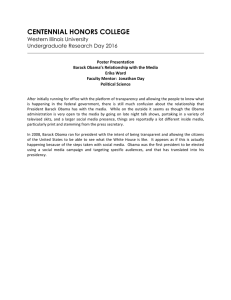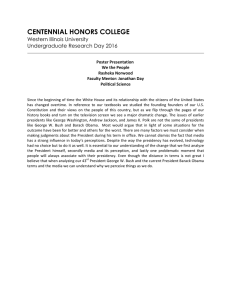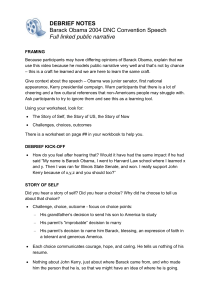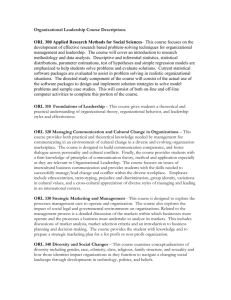Online Inference-Rule Learning from Natural-Language Extractions Sindhu Raghavan and Raymond J. Mooney
advertisement
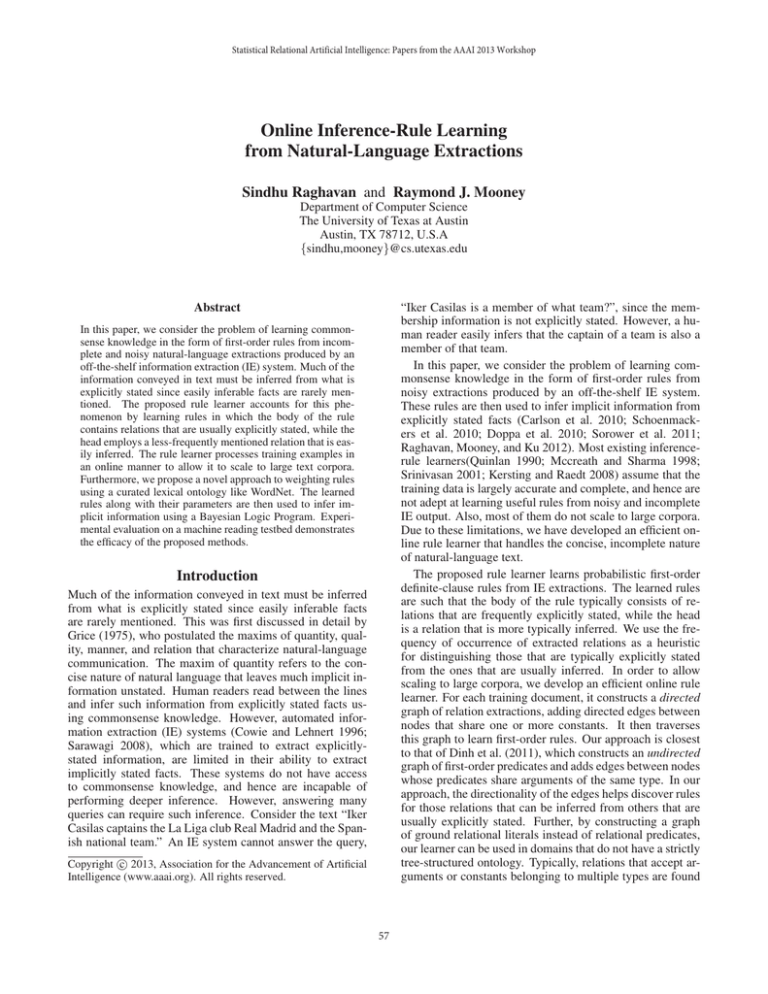
Statistical Relational Artificial Intelligence: Papers from the AAAI 2013 Workshop
Online Inference-Rule Learning
from Natural-Language Extractions
Sindhu Raghavan and Raymond J. Mooney
Department of Computer Science
The University of Texas at Austin
Austin, TX 78712, U.S.A
{sindhu,mooney}@cs.utexas.edu
“Iker Casilas is a member of what team?”, since the membership information is not explicitly stated. However, a human reader easily infers that the captain of a team is also a
member of that team.
In this paper, we consider the problem of learning commonsense knowledge in the form of first-order rules from
noisy extractions produced by an off-the-shelf IE system.
These rules are then used to infer implicit information from
explicitly stated facts (Carlson et al. 2010; Schoenmackers et al. 2010; Doppa et al. 2010; Sorower et al. 2011;
Raghavan, Mooney, and Ku 2012). Most existing inferencerule learners(Quinlan 1990; Mccreath and Sharma 1998;
Srinivasan 2001; Kersting and Raedt 2008) assume that the
training data is largely accurate and complete, and hence are
not adept at learning useful rules from noisy and incomplete
IE output. Also, most of them do not scale to large corpora.
Due to these limitations, we have developed an efficient online rule learner that handles the concise, incomplete nature
of natural-language text.
The proposed rule learner learns probabilistic first-order
definite-clause rules from IE extractions. The learned rules
are such that the body of the rule typically consists of relations that are frequently explicitly stated, while the head
is a relation that is more typically inferred. We use the frequency of occurrence of extracted relations as a heuristic
for distinguishing those that are typically explicitly stated
from the ones that are usually inferred. In order to allow
scaling to large corpora, we develop an efficient online rule
learner. For each training document, it constructs a directed
graph of relation extractions, adding directed edges between
nodes that share one or more constants. It then traverses
this graph to learn first-order rules. Our approach is closest
to that of Dinh et al. (2011), which constructs an undirected
graph of first-order predicates and adds edges between nodes
whose predicates share arguments of the same type. In our
approach, the directionality of the edges helps discover rules
for those relations that can be inferred from others that are
usually explicitly stated. Further, by constructing a graph
of ground relational literals instead of relational predicates,
our learner can be used in domains that do not have a strictly
tree-structured ontology. Typically, relations that accept arguments or constants belonging to multiple types are found
Abstract
In this paper, we consider the problem of learning commonsense knowledge in the form of first-order rules from incomplete and noisy natural-language extractions produced by an
off-the-shelf information extraction (IE) system. Much of the
information conveyed in text must be inferred from what is
explicitly stated since easily inferable facts are rarely mentioned. The proposed rule learner accounts for this phenomenon by learning rules in which the body of the rule
contains relations that are usually explicitly stated, while the
head employs a less-frequently mentioned relation that is easily inferred. The rule learner processes training examples in
an online manner to allow it to scale to large text corpora.
Furthermore, we propose a novel approach to weighting rules
using a curated lexical ontology like WordNet. The learned
rules along with their parameters are then used to infer implicit information using a Bayesian Logic Program. Experimental evaluation on a machine reading testbed demonstrates
the efficacy of the proposed methods.
Introduction
Much of the information conveyed in text must be inferred
from what is explicitly stated since easily inferable facts
are rarely mentioned. This was first discussed in detail by
Grice (1975), who postulated the maxims of quantity, quality, manner, and relation that characterize natural-language
communication. The maxim of quantity refers to the concise nature of natural language that leaves much implicit information unstated. Human readers read between the lines
and infer such information from explicitly stated facts using commonsense knowledge. However, automated information extraction (IE) systems (Cowie and Lehnert 1996;
Sarawagi 2008), which are trained to extract explicitlystated information, are limited in their ability to extract
implicitly stated facts. These systems do not have access
to commonsense knowledge, and hence are incapable of
performing deeper inference. However, answering many
queries can require such inference. Consider the text “Iker
Casilas captains the La Liga club Real Madrid and the Spanish national team.” An IE system cannot answer the query,
c 2013, Association for the Advancement of Artificial
Copyright Intelligence (www.aaai.org). All rights reserved.
57
in ontologies which have the structure of a DAG (directed
acyclic graph) rather than a tree. Accommodating such an
ontology is critical to handling the machine-reading corpus
used in our experiments. The approach by Dinh et al. is
not directly applicable to such domains since it relies on a
unique type for each predicate argument.
After learning first-order rules, they are used to infer additional information from that explicitly extracted from future
documents. Approaches to inference use either purely logical deduction, which fails to account for the uncertainty inherent in such rules, or a probabilistic logic such as Markov
Logic Networks (MLNs) (Domingos and Lowd 2009) or
Bayesian Logic Programs (BLPs) (Kersting and De Raedt
2007). Based on a recent study by Raghavan et al. (2012)
that demonstrated the superior performance of BLPs compared to MLNs and logical deduction, we use BLPs to support inference.
Probabilistic inference in BLPs requires specifying
conditional-probability parameters for the first-order rules.
Since relations that are easily inferred from stated facts are
seldom seen in the training data, learning useful parameters using conventional BLP-parameter-learning approaches
like EM (Kersting and Raedt 2008) has had limited success
(Raghavan, Mooney, and Ku 2012). Consequently, we propose an alternate approach to specifying parameters for the
learned first-order rules using lexical knowledge from a curated ontology like WordNet (Fellbaum 1998). The basic
idea behind our approach is that more accurate rules typically have predicates that are closely related to each other
in terms of the meanings of the English words used to name
them.
The main contributions of this paper are therefore:
Given a knowledge base as a BLP, standard logical inference (SLD resolution) is used to automatically construct a
Bayes net for a given problem. More specifically, given a
set of facts and a query, all possible definite-clause proofs
of the query are constructed and used to build a Bayes net
for answering that query. The probability of a joint assignment of truth values to the final set of ground propositions is
defined as follows:
P(X) = i P (Xi |P a(Xi )),
where X = X1 , X2 , ..., Xn represents the set of random
variables in the network and P a(Xi ) represents the parents
of Xi . Once a ground network is constructed, standard probabilistic inference methods can be used to answer various
types of queries (Koller and Friedman 2009). BLP parameters can be learned using EM as described by Kersting and
De Raedt (2008).
Online Rule Learner
In this section, we describe our online rule learner for inducing probabilistic first-order rules from the output of an
off-the-shelf IE system. It involves constructing a directed
graph of relation extractions for each training example and
connecting those relations that share one or more constants
with a directed edge. Nodes connected to one another by
edges typically represent relations that might be related, and
hence might participate in the same rule. The edges are
added from relations that are usually explicitly stated in text
to those that can be inferred. Since relations that are implicitly stated occur less frequently in the training data, we
use the frequency of occurrence of relation predicates as a
heuristic to determine if a particular relation is best inferred
from other relations. While the frequency of occurrence of
relations is a good heuristic, this assumption does not necessarily hold for all relations.
The pseudocode for our Online Rule Learner (ORL) is
shown in Algorithm 1. It accepts a set of training examples,
where each example consists of a set of facts an IE system
has extracted from a single document. The learner processes
one example at a time in an online manner as follows. First,
it updates counts for the frequency of occurrence for each
relational predicate seen in the training example. Then, it
builds a directed graph whose nodes represent relation extractions seen in the example. Note that entity types are not
added to the graph. The rule learner then adds directed edges
between every pair of nodes whose relations share one or
more constants as arguments. The direction of the edge is
determined as follows – for every pair (x,y) of relations that
share constants, if the relation predicate of x is seen more
frequently than that of y in the training set so far, then the
learner adds a directed edge from x to y since y is more
likely to be inferred from x.
Once all documents are processed, the learner traverses
the resulting graph to construct rules. For each directed edge
(x,y) in the graph, it constructs a rule in which the body contains x and y is the head. It then adds types corresponding
to the constants in x. If a constant is associated with multiple types, i.e if the extractor has extracted multiple types for
a constant, then we create a separate rule for each type ex-
• A novel online rule learner that efficiently learns accurate
rules from noisy and incomplete natural-language extractions.
• A novel approach to weighting such rules using lexical
information from a curated ontology like WordNet (Fellbaum 1998).
Bayesian Logic Programs
Bayesian logic programs (BLPs) (Kersting and De Raedt
2007; Kersting and Raedt 2008) can be viewed as templates for constructing directed graphical models (Bayes
nets). Formally, a BLP consists of a set of Bayesian clauses,
definite clauses of the form a|a1 , a2 , a3 , .....an , where n ≥
0 and a, a1 , a2 , a3 ,......,an are Bayesian predicates (defined below), and where a is called the head of the clause
(head(c)) and (a1 , a2 , a3 ,....,an ) is the body (body(c)).
When n = 0, a Bayesian clause is a fact. Each Bayesian
clause c is assumed to be universally quantified and range
restricted, i.e variables{head} ⊆ variables{body}, and
has an associated conditional probability table CPT(c) =
P(head(c)|body(c)). A Bayesian predicate is a predicate
with a finite domain, and each ground atom for a Bayesian
predicate represents a random variable. Associated with
each Bayesian predicate is a combining rule such as noisyor or noisy-and that maps a finite set of CPTs into a single
CPT.
58
(a) Example text in training
“Barack Obama is the 44th and the current President of USA. Obama, citizen of
USA was born on August 4, 1961 in Hawaii, USA.”
Algorithm 1 Online Rule Learner
Inputs: Training examples D, target predicates T , and number of
rules to output per predicate n. Each example Di consists of
a set of extractions.
Output: First-order definite-clause rules R for target predicates
T.
1: for each example Di do
2:
for each extraction x in Di do
3:
Get the predicate Rx for x
4:
if Rx is a relation predicate then
5:
Increment count for Rx
6:
end if
7:
end for
8:
Construct a directed graph Gi in which relation extractions
are nodes.
9:
for each pair of relations x and y that share one or more
constants do
10:
Let Rx be the predicate of x and Ry be the predicate of
y
11:
if count of Ry < count of Rx then
12:
Add an edge from x to y
13:
end if
14:
end for
15:
for each relation x do
16:
for each outgoing edge (x,y) from x do
17:
Let y be the head node of the edge
18:
Create a rule Rj x → y
19:
for each constant ck in x do
20:
Add the type corresponding to ck to the body of Rj
21:
end for
22:
Replace all constants in Rj with unique variables to
create a first-order rule F Rj
23:
if F Rj is range restricted then
24:
Add F Rj to R and update the support for F Rj
25:
end if
26:
end for
27:
end for
28: end for
29: Sort rules in the descending order of their support and output
top n rules for each predicate.
(b) IE extractions
nationState(usa)
person(barack obama)
isLedBy(usa,barack obama)
hasBirthPlace(barack obama,usa)
hasCitizenship(barack obama,usa)
(c)Frequency counts for relation predicates
isLedBy: 30, hasBirthPlace: 23, hasCitizenship: 20
(d) Directed graph constructed from extracted relations
(e) Ground rules constructed by ORL
isLedBy(usa,barack obama) ∧ person(barack obama) ∧ nationState(usa)
→ hasBirthPlace(barack obama,usa)
isLedBy(usa,barack obama) ∧ person(barack obama) ∧ nationState(usa)
→ hasCitizenship(barack obama,usa)
hasBirthPlace(barack obama,usa) ∧ person(barack obama) ∧ nationState(usa)
→ hasCitizenship(barack obama,usa)
(f) First order rules constructed by ORL
isLedBy(X,Y) ∧ person(Y) ∧ nationState(X) → hasBirthPlace(Y,X)
isLedBy(X,Y) ∧ person(Y) ∧ nationState(X) → hasCitizenship(Y,X)
hasBirthPlace(X,Y) ∧ person(X) ∧ nationState(Y) → hasCitizenship(X,Y)
Figure 1: Example Showing Various Stages of the ORL Algorithm
tracted for the constant. This is needed in domains that have
a DAG-structured ontology as described earlier. Finally, it
replaces all constants in the rule with unique variables to
create a first-order rule. All first-order rules that are range
restricted (all variables in the head appear in the body) are
retained and the remaining rules are discarded.
The training phase ends when the rule learner has processed all examples in the training set. It then outputs the
top n rules per predicate, where n is a value provided by
the user. The rules are sorted in descending order of their
support, which refers to to the number of times the rule is
satisfied in the training set (Agrawal, Imieliński, and Swami
1993). Alternately, the rule learner could output only those
rules whose support meets a user-specified threshold.
In the basic algorithm, we have considered rules in which
the body of the rule has a single relational literal. However,
we can extend the algorithm in several ways to search for
rules that have several relational literals in their body. For instance, given two rules A → B and C → B, the rule learner
can propose a new rule A∧C → B. An alternate approach is
to follow the directed edges for a given path length and add
all relations except that corresponding to the end node in the
path to the rule body and make the relation corresponding to
the end node the head. The basic algorithm worked best for
our application domain and hence we learned rules with just
a single relation in the rule body.
In some ways, the rules learned by this approach are similar to the typed entailment rules considered by Berant et al.
(2011). However, as described above, unlike their approach,
our method is not limited to learning rules with a single relation in the body. Furthermore, approaches that learn typed
entailment rules like Berant et al.’s do not handle DAG ontologies in which relations can take arguments of multiple
types. On the other hand, our method explicitly handles this
situation.
Consider the example shown in the Figure 1. Figure 1a
shows a sample training document and Figure 1b shows
the corresponding IE output. Given these extractions and
59
employs
eventLocationGPE
hasMemberPerson
mediatingAgent
hasMemberHumanAgent
hasBirthPlace
hasCitizenship
the frequency counts for relational predicates seen so far
in training (Figure 1c), ORL constructs a directed graph
with relation extractions isLedBy(usa,barack obama), hasBirthPlace(barack obama,usa), and hasCitizenship(barack
obama,usa) as nodes (Line 8 in Algorithm 1). It then adds
directed edges between nodes that share constants barack
obama and usa. The direction is determined by the frequency counts of the relations isLedBy, hasCitizenship, and
hasBirthPlace as described in Lines 9–14 in Algorithm 1.
After constructing the graph, ORL constructs rules as described in Lines 16–21. Finally, it replaces the constants
barack obama and usa with variables to construct first-order
rules (Lines 22). Since all three rules are range restricted,
they are all kept.
eventLocation
hasMember
isLedBy
thingPhysicallyDamaged
killingHumanAgent
thingPhysicallyDestroyed
attendedSchool
Table 1: Target Relations Selected for Evaluation
data set, which consists of news articles on terrorist events
around the world. Our specific data set consists of 10, 000
documents, each containing an average of 93.14 facts extracted by S IRE (Florian et al. 2004), an IE system developed
by IBM.
The ontology provided by DARPA for the IC domain consists of 57 entity types and 79 relations. The entity types include Agent, PhysicalThing, Event, TimeLocation, Gender,
and Group, each with several subtypes. The type hierarchy
is a DAG rather than a tree, and several types have multiple
super-classes. For instance, a GeopoliticalEntity can be a
HumanAgent as well as a Location.
Weighting Rules with WordNet
We now discuss our new approach to determining parameters for the learned first-order rules. Our approach learns
weights between 0 and 1, where a higher weight represents
higher confidence. These weights are used as noisy-or parameters when performing probabilistic inference in the resulting BLP (Kersting and Raedt 2008; Raghavan, Mooney,
and Ku 2012). Since the predicate names in most ontologies
employ ordinary English words, we hypothesized that more
confident rules have predicates whose words are more semantically related. We use the lexical information in WordNet (Fellbaum 1998) to measure word similarity.
WordNet is a lexical knowledge base covering around
130,000 English words in which nouns, verbs, adverbs,
and adjectives are organized into synonym sets, also called
synsets. We used the wup measure by Wu and Palmer (1994)
as implemented in WordNet::Similarity (Pedersen, Patwardhan, and Michelizzi 2004) to measure semantic distances between words. This measure computes the depth of the least
common subsumer (LCS) of the given words and then scales
it by the sum of the depths of the given words. We used the
wup similarity score since it computes a (scaled) similarity
scores between 0 and 1, which are easily used as weights for
our rules.
We compute the wup similarity for every pair of words
(wi ,wj ) in a given rule, where wi is a word in the body and
wj is a word in the head. The words in a given rule are the
predicate names of relations and entity types, which are usually English words. However, for predicate names like hasCitizenship or hasMember that are not single English words,
we segment the name into English words such as has, citizenship, and member, and then remove stop words. The final
weight for a rule is the average similarity between all pairs
(wi ,wj ), which basically measures how closely predicates in
the body are related to the predicate in the head. Using the
highest similarity score between all word pairs or between
words from relation predicates only as the rule weight did
not yield meaningful results.
BLP Parameters and Inference
We used a deterministic logical-and model to encode the
CPT entries for the Bayesian clauses and a noisy-or model
to combine evidence from multiple rules that have the same
head (Pearl 1988). As shown later, given the limited amount
of training data available for each relation, learning noisyor parameters using the EM algorithm developed for BLPs
(Kersting and Raedt 2008) did not give very good results.
Consequently, we manually set the noisy-or parameters for
all rules to 0.9, since this approach has been shown to work
well in the IC domain (Raghavan, Mooney, and Ku 2012).
To infer implicit relations, we performed BLP inference using SampleSearch (Gogate and Dechter 2007) to compute
marginal probabilities.
Evaluation Metric
We evaluated our approach by performing 10-fold cross validation on this data. We learned first-order rules using 14
target relations given in Table 1 that had an appreciable
amount of data. To measure performance, we randomly
sampled 4 documents from each test set, 40 documents in
total. We manually evaluated the inferences for these test
documents since there is no ground truth available for this
data set. We ranked all inferences in descending order of
their marginal probability and computed precision for the
top n inferences. Precision measures the fraction of inferences that were judged correct. Our evaluation is similar
to that used in previous related work (Carlson et al. 2010;
Schoenmackers et al. 2010; Raghavan, Mooney, and Ku
2012).
Experimental Evaluation
Evaluation of Online Rule Learner
Data
The systems compared in our experiments are:
We evaluated our approaches to rule learning and weighting
on DARPA’s machine-reading intelligence-community (IC)
• ORL: This approach learns rules using the online rule
learner described earlier. For each target relation, we
60
isLedBy(B,A) ∧ person(A) ∧ nationState(B)
→ hasBirthPlace(A,B) (0.62)
Full-set
1
ORL
LIME
COMBINED
0.9
If person A leads a nation B, then A is born in B
thingPhysicallyDamaged(A,B) ∧ bombing(A) ∧ nationState(B)
→ eventLocation(A,B) (0.71)
0.8
0.7
Precision
If a nation B is physically damaged in a bombing event A,
then the event location of A is B
employs(A,B) ∧ humanOrganization(A) ∧ personGroup(B)
→ hasMemberHumanAgent(A,B) (0.57)
0.6
0.5
0.4
0.3
If a human organization A employs B, then B is a member of A
isLedBy(B,A) ∧ nationState(B)
→ hasCitizenship(A,B) (0.48)
0.2
0.1
0
If a nation B is led by A, then A is a citizen of B
0
100
200
300
400
500
600
700
800
900
1000
Top−n
Subset
Table 2: Sample Rules Learned by ORL
1
ORL
LIME
COMBINED
0.9
0.8
specify the number of rules to output to be 10. Table 2
gives some sample rules learned by ORL along with rule
weights computed using the approach described earlier.
Precision
0.7
• LIME: Raghavan et al. (2012) demonstrated that L IME
(Mccreath and Sharma 1998), an existing Inductive Logic
Programming (ILP) system, could learn accurate rules for
the IC data set, and hence we use it as a baseline. Like
Raghavan et al., we learned rules using only positive instances and using both positive and negative instances for
each target relation, where negative instances were generated using the closed world assumption. The final BLP
included rules learned from both settings.1
0.6
0.5
0.4
0.3
0.2
0.1
0
0
100
200
300
400
500
600
700
800
900
1000
Top−n
Figure 2: Precision at Top-n on the Full-set (top) and Subset
(bottom) of Target Relations.
• COMBINED: This approach combines rules from both
ORL and L IME into a single BLP.
model only. In general, performance of all models on the
Subset is better than that on the Full-set since the difficult
relations have been removed.
ORL takes 3.8 minutes per fold on an average to learn
rules, while L IME takes 11.23 hours to learn rules. As discussed by Raghavan et al. (2012), since L IME does not scale
to large data sets, we ran L IME on smaller subsets of the
training data and combined the results in order to process
the full IC data. The runtime includes the total time taken
to produce the final set of rules. Unlike ORL, L IME learns
first-order rules for each target predicate separately, further
increasing its running time. On the other hand, ORL learns
rules for all target predicates during one pass through the
training data. As a result, ORL trains two orders of magnitude faster than L IME. The timing information empirically
demonstrates ORL’s ability to effectively scale to large data
sets.
We observed that all methods learn inaccurate rules for certain target relations like mediatingAgent and attendedSchool
since they are less easily inferred compared to other relations
such as hasMember that are more easily inferred. Therefore, we removed 4 relations – mediatingAgent, attendedSchool, thingPhysicallyDamaged, and thingPhysicallyDestroyed from the original set and also report results for the
remaining 10 target relations. We refer to the original set of
target relations as “Full-set” and the reduced set as “Subset”.
Figure 2 gives the precision at top-n for inferences made
by rules learned using ORL, L IME, and COMBINED on
both the Full-set and Subset of target relations. On the Fullset, L IME outperforms ORL at the initial points on the curve,
while ORL outperforms L IME by a significant margin at
later points on the curve. However, on the Subset, ORL
outperforms L IME at all points on the curve. A closer examination of the rules learned by both approaches revealed
that ORL learned rules that were more specific than L IME’s.
As a result, ORL makes fewer but more accurate inferences.
On both Full-set and Subset, COMBINED outperforms both
ORL and L IME for both target sets, indicating a definite
advantage to combining rules from both L IME and ORL.
Therefore, for the rest of the paper, we use the COMBINED
Evaluation of Weighting Rules with WordNet
We also computed noisy-or parameters using the lexical approach described earlier for all rules in the COMBINED
model. For the baseline, we set all noisy-or parameters to
0.9 and performed inference in the BLP framework. We refer to the former as “WUP” and the latter as “Default”. For
the Subset of target relations, we also compare to learning
noisy-or parameters using EM (Kersting and Raedt 2008).
We were unable to learn noisy-or parameters on the Fullset due to the large size of the networks, which made both
1
Note that our results can not be directly compared to that of
Raghavan et al.’s due to differences in the exact set of target predicates selected.
61
Full-set
The first category consists of rule learners (Quinlan 1990;
Mccreath and Sharma 1998; Kersting and Raedt 2008;
Dinh, Exbrayat, and Vrain 2011; Kok and Domingos 2009;
2010) that expect the training data to be complete and accurate, due to which they are less suited for learning effective inference rules from noisy, incomplete IE extractions.
The second category consists of rule learners (Schoenmackers et al. 2010; Sorower et al. 2011) that are specifically
developed for learning probabilistic rules from IE extractions using the MLN framework. These approaches perform
an exhaustive search, which becomes computationally intractable for larger datasets. The third category consists of
approaches (Lin and Pantel 2001; Yates and Etzioni 2007;
Berant, Dagan, and Goldberger 2011) that learn entailment
rules that are typically restricted to having antecedents with
a single literal, and have utilized binary logic rather than
a well-founded probabilistic logic such as MLNs or BLPs,
and therefore are unable to systematically integrate evidence
from multiple rules to produce confidences in their inferences.
Basu et al. (2001) use WordNet distances to estimate the
novelty of rules discovered by data-mining systems. Feldman and Dagan (1995) and Han and Fu (1995) use domainspecific concept hierarchies to weight and filter redundant
rules. Garrette et al. (2011) use distributional lexical semantics to set weights for rules in an MLN.
1
Default
WUP
0.9
0.8
Precision
0.7
0.6
0.5
0.4
0.3
0.2
0.1
0
0
100
200
300
400
500
600
700
800
900
1000
Top−n
Subset
1
Default
WUP
EM
0.9
0.8
Precision
0.7
0.6
0.5
0.4
0.3
0.2
0.1
0
0
100
200
300
400
500
600
700
800
900
1000
Top−n
Conclusions and Future Work
Figure 3: Precision at Top-n for COMBINED using Different Weights on the Full-set (top) and Subset (bottom) of
Target Relations.
We have introduced a novel online learner for inducing firstorder inference rules from noisy and incomplete extractions
from an off-the-shelf IE system. Experimental comparisons
to L IME, an existing rule-learner on the machine reading
task has demonstrated that our approach generally learns
rules of equal or greater accuracy in significantly less time.
However, the best predictive accuracy was obtained when
rules from both approaches were combined. We have also
presented a novel approach to weighting inference rules using WordNet lexical similarity, demonstrating superior predictive accuracy compared to default parameters or those
learned using EM.
Future work includes developing better techniques for
learning BLP parameters in the presence of limited, noisy
data and performing large scale evaluation of our approach
on larger test sets by employing crowdsourcing via Amazon Mechanical Turk. Using lexical knowledge to initialize
the weights and then using EM to improve the weights is another direction for future work. Finally, we would like to explore using distributional lexical semantics to compute word
similarities for weighting rules (Garrette, Erk, and Mooney
2011).
logical and probabilistic inference intractable on several examples.
Figure 3 gives the precision for inferences made with
the COMBINED model using different weights on both the
Full-set and Subset of target relations. On both sets, WUP
outperforms Default indicating the efficacy of our approach
for learning weights using WordNet. On the Subset, EM
weights slightly outperform both Default and WUP weights
for the top 25 inferences; however, the precision for EM
weights drops significantly for higher values of n, indicating that the learned weights are not very good, possibly due
to the lack of sufficient training data. When selecting an average of 1 inference per document, WUP gives a precision
of 80.6% and 90% on the Full-set and Subset respectively.
Overall, our online rule learner produces accurate rules
very efficiently. Even though it does not always outperform
L IME, combining rules from both approaches results in a
model that gives the best performance on the IC data set.
Though weight learning using conventional parameter learning techniques like EM did not yield reasonable results, our
approach to weighting rules using WordNet similarity shows
significant promise.
Acknowledgements
This research was funded by MURI ARO grant W911NF08-1-0242, Air Force Contract FA8750-09-C-0172 under
the DARPA Machine Reading Program, and DARPA DEFT
program under AFRL grant FA8750-13-2-0026. Experiments were run on the Mastodon Cluster provided by NSF
grant EIA-0303609.
Related Work
Approaches proposed in the literature for learning firstorder rules generally fall into one of three categories.
62
References
of learning Bayesian Logic Programs. Berlin, Heidelberg:
Springer-Verlag.
Kok, S., and Domingos, P. 2009. Learning Markov logic
network structure via hypergraph lifting. In Proceedings of
ICML 2009, 505–512. ACM.
Kok, S., and Domingos, P. 2010. Learning Markov logic
networks using structural motifs. In Proceedings of ICML
2010, 551–558.
Koller, D., and Friedman, N. 2009. Probabilistic Graphical
Models: Principles and Techniques. MIT Press.
Lin, D., and Pantel, P. 2001. Discovery of inference rules
for question answering. Natural Language Engineering
7(4):343–360.
Mccreath, E., and Sharma, A. 1998. Lime: A system for
learning relations. In Ninth International Workshop on Algorithmic Learning Theory, 336–374. Springer-Verlag.
Pearl, J. 1988. Probabilistic Reasoning in Intelligent Systems: Networks of Plausible Inference. San Mateo,CA:
Morgan Kaufmann.
Pedersen, T.; Patwardhan, S.; and Michelizzi, J. 2004.
Wordnet:: Similarity - measuring the relatedness of concepts. In Proceedings of AAAI 2004, 1024–1025.
Quinlan, J. R. 1990. Learning logical definitions from relations. Machine Learning 5(3):239–266.
Raghavan, S.; Mooney, R. J.; and Ku, H. 2012. Learning to
read between the lines using Bayesian Logic Programs. In
Proceedings of ACL 2012.
Sarawagi, S. 2008. Information extraction. Foundations and
Trends in Databases 1(3):261–377.
Schoenmackers, S.; Etzioni, O.; Weld, D. S.; and Davis, J.
2010. Learning first-order Horn clauses from web text. In
Proceedings of EMNLP 2010, 1088–1098. Stroudsburg, PA,
USA: Association for Computational Linguistics.
Sorower, M. S.; Dietterich, T. G.; Doppa, J. R.; Walker, O.;
Tadepalli, P.; and Fern, X. 2011. Inverting Grice’s maxims
to learn rules from natural language extractions. In Proceedings of NIPS 2011.
Srinivasan, A. 2001. The Aleph manual. http://web.comlab.
ox.ac.uk/oucl/research/areas/machlearn/Aleph/.
Wu, Z., and Palmer, M. 1994. Verb semantics and lexical
selection. In Proceedings of ACL 1994, 133–138.
Yates, A., and Etzioni, O. 2007. Unsupervised resolution of
objects and relations on the web. In Proceedings of NAACLHLT 2007.
Agrawal, R.; Imieliński, T.; and Swami, A. 1993. Mining
association rules between sets of items in large databases. In
Proceedings of the SIGMOD 1993, 207–216.
Basu, S.; Mooney, R. J.; Pasupuleti, K. V.; and Ghosh, J.
2001. Evaluating the novelty of text-mined rules using lexical knowledge. In Proceedings KDD 2001, 233–239.
Berant, J.; Dagan, I.; and Goldberger, J. 2011. Global learning of typed entailment rules. In Proceedings of ACl-HLT
2011, 610–619.
Carlson, A.; Betteridge, J.; Kisiel, B.; Settles, B.; Jr., E. H.;
and Mitchell, T. 2010. Toward an architecture for neverending language learning. In Proceedings of AAAI 2010,
1306–1313. AAAI Press.
Cowie, J., and Lehnert, W. 1996. Information extraction.
CACM 39(1):80–91.
Dinh, Q.-T.; Exbrayat, M.; and Vrain, C. 2011. Generative
structure learning for Markov logic networks based on graph
of predicates. In Proceedings of IJCAI 2011, IJCAI 2011,
1249–1254. AAAI Press.
Domingos, P., and Lowd, D. 2009. Markov Logic: An Interface Layer for Artificial Intelligence. San Rafael, CA:
Morgan & Claypool.
Doppa, J. R.; NasrEsfahani, M.; Sorower, M. S.; Dietterich,
T. G.; Fern, X.; and Tadepalli, P. 2010. Towards learning
rules from natural texts. In Proceedings of FAM-LbR 2010,
70–77. Stroudsburg, PA, USA: Association for Computational Linguistics.
Feldman, R., and Dagan, I. 1995. Knowledge discovery in
textual databases (kdt). In Proceedings of KDD 1995, 112–
117. AAAI Press.
Fellbaum, C., ed. 1998. WordNet: An Electronic Lexical
Database. Cambridge, MA: The MIT Press.
Florian, R.; Hassan, H.; Ittycheriah, A.; Jing, H.; Kambhatla, N.; Luo, X.; Nicolov, N.; and Roukos, S. 2004. A
statistical model for multilingual entity detection and tracking. In Proceedings of NAACL-HLT 2004, 1–8.
Garrette, D.; Erk, K.; and Mooney, R. 2011. Integrating
logical representations with probabilistic information using
Markov logic. In Proceedings of ICCS 2011, 105–114.
Gogate, V., and Dechter, R. 2007. Samplesearch: A scheme
that searches for consistent samples. In Proceedings of AISTATS 2007.
Grice, H. P. 1975. Logic and conversation. In Cole, P., and
Morgan, J. L., eds., Syntax and Semantics: Vol. 3: Speech
Acts. San Diego, CA: Academic Press. 41–58.
Han, J., and Fu, Y. 1995. Discovery of multiple-level association rules from large databases. In Proceedings of VLDB
1995, 420–431.
Kersting, K., and De Raedt, L. 2007. Bayesian Logic Programming: Theory and tool. In Getoor, L., and Taskar, B.,
eds., Introduction to Statistical Relational Learning. Cambridge, MA: MIT Press.
Kersting, K., and Raedt, L. D. 2008. Basic principles
63
